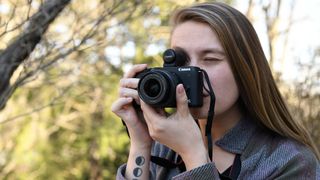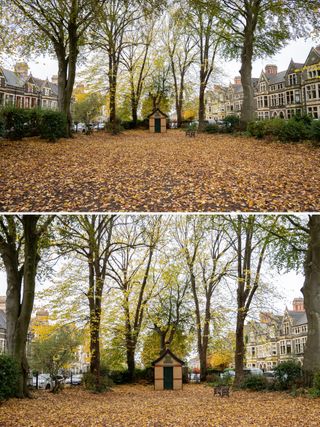Optical zoom vs. digital zoom: which is better for you?
Optical zoom vs. digital zoom: what's the difference and which one should you choose?

Can't decide between lenses? Understanding the optical zoom vs. digital zoom argument may help you make the right purchase. If you want to photograph a subject which is some distance away from you, then you’ve generally got three options.
You can either physically move yourself closer to the subject, you can optically zoom in to the subject, or you can apply a digital zoom. The first option might not always be possible, but is there a big difference between the other two?
Optical zoom and digital zoom are phrases you may have also seen written on boxes and in specs lists when shopping for the best cameras, and increasingly so, the best camera phones. You might have no idea what they mean, and certainly how the two differ. Luckily, we’re here to help you out.
Received wisdom tells us that optical zoom is always better than digital zoom. However, there have been lots of advances in camera and smartphone technology in recent years that means digital is not necessarily always the least favorable option, as it has traditionally been seen.
To help you understand the differences between the two, and to decide whether optical or digital zoom is right for your needs, this guide is going to weigh up the pros and cons of both. All you need to do now is read on.
Optical zoom vs. digital zoom: what is optical zoom?
Optical zoom works by using lenses to magnify a far off image, filling the entirety of the image sensor. You’ll see lots of cameras and zoom lenses listed by their zoom ratio, say 3x, 10x, 20x, 30x or even beyond in some cases. A true zoom lens uses optics within a single housing to move from one focal length to another, say from 24mm to 70mm, with the ability to use other focal lengths in between, such as 35mm or 50mm too — and often anything in between, like 36mm or 47mm. It means you only have to carry one lens around with you, rather than a set of different “prime” lenses (see below).
You'll often see standalone zoom lenses used on interchangeable lens cameras (ILCs) like DSLR or mirrorless cameras. You will also see zoom lenses built into many compact and bridge cameras. In all these cameras, the lenses zoom by changing the space between the optics within the camera and the camera's sensor, changing the focal length and thereby providing optical zoom.

Smartphones usually work in a different way. Smartphones will oftentimes claim to have an optical zoom, but this doesn't work in the same way as a true zoom lens on a camera. Usually, the phone has additional fixed lenses which offer a longer focal length than the standard lens, or an ultra wide angle lens. If you see, for example, a claim which says that a smartphone offers “6x zoom”, it could be that it has an ultra wide angle lens with a 13mm focal length, and a telephoto zoom with a 78mm focal length — therefore meaning the difference between all of the lenses is 6x. To zoom in, the smartphone simply switches from the wider 13mm lens to the 78mm lens (or other lenses in between). This means you can't choose any focal length in between.
Because the phone is using different focal length optics (lenses) to actually magnify the scene, this is still a type of optical zoom.
Optical zoom vs. digital zoom: what is digital zoom?
Digital zoom works simply by cropping into the center of an image, which means that you will usually lose pixels in the process, causing a loss of resolution and fuzziness. This is why digital zoom often gets a bad rep when compared to optical zoom.
However, in recent years there have been advancements in digital zoom, often using software. An image may be scaled up by the camera using interpolation (adding made up pixels back in, using the camera’s internal software to decide what color they should be in relation to nearby original pixels) in order to return to the original photo resolution.

Digital zoom is also less of a problem if you’re using a very high resolution sensor in the first place, since, even without interpolation, you’ll still be left with a decently sized image for reproduction or even printing. Both of these factors used to be more of a problem when sensors had lower resolutions, and computational photography was not as advanced as it is today.
With both modern dedicated cameras and smartphones that have very high pixel counts and powerful image processors, using digital zoom can produce good results. This means it can be a viable, if not good zooming option, especially if used in conjunction with optical zoom.
Zoom lenses vs prime lenses
If you’re buying a lens for your digital camera, then your choices will be between zoom lenses or prime lenses.
Zoom lenses, as we've discussed, give you the flexibility to move between different focal lengths, all within one zoom. This is known as optical zoom. Prime lenses by contrast offer a fixed focal length, meaning you can’t zoom optically (although you can still zoom digitally). The two options represent a trade off. Zoom lenses give you much more versatility, giving you the option to photograph different types of subjects at different focal lengths, and being easier to fit in your kit bag.


Prime lenses meanwhile tend to be sharper, and they tend to also offer a wider aperture, giving you better results in low light, as well as a better ability to create blurred backgrounds.
Lots of compact and bridge cameras (these are DSLR-style cameras with fixed, non-interchangeable lenses) offer digital zooming, allowing you to go beyond the reach of whatever is offered by the built-in zoom lens.

Interchangeable lens cameras don’t tend to offer it in such straightforward terms, but it might still be there. For example, in Nikon full-frame cameras you’ll find the option to shoot in “DX mode” (APS-C). This is an option for anybody that wants to get closer to their subject — such as wildlife photographers — as the camera will crop into the center of the image. Again, though, you will sacrifice resolution to do so.
How does smartphone zoom work?
Almost all smartphones these days offer at least two lenses to choose between. It is still rare however for any of these individual lenses to be a "true optical zoom” (i.e. a single unit with optics that zoom from one focal length to another) — the Sony Xperia 1 IV is an unusual exception, as it includes an 85mm-125mm telephoto zoom lens as one its trio of optics. Theoretically, you can select a focal length anywhere between 85mm and 125mm using that lens.
For most common smartphones, including the iPhone and Samsung models, what you tend to get is a “1x” lens, joined by an ultra wide angle lens (0.5x), and in more expensive or flagship models at least one “telephoto” or “zoom” lens (depending on how the marketers want to term it).

If you want to go further than the longest telephoto zoom available, then you’ll find yourself entering digital zoom territory. An extreme example of this is with the Samsung S22 Ultra, which offers “100x Space Zoom”. The results aren’t particularly impressive in themselves, as they usually lack detail and can appear quite smudgy (see our example below), but they do show proof of concept — and it’s something that is likely to get better as technology evolves.

Using a high-resolution sensor is another way that smartphone manufacturers can offer an increased zoom. A good example of this is the iPhone 14 Pro, which includes a 48 megapixel sensor, going beyond 12 megapixels for the first time in an Apple device. Despite its high resolution, the phone uses something called “pixel binning” to combine pixels for better performance, outputting images at 12 megapixels. As well as being better for low light performance, this also gives users a “2x zoom” option, even though none of the lenses offer that focal length. It works by cropping into the center of the image, and since there’s 48 megapixels to play with, the resulting outputted image can still be 12 megapixels.
Smartphones will often also use digital zooming in low-light situations, even if they have zoom lenses, since the sensors and lenses of the “main” lens can usually perform better when there isn’t much light available. For example, you might think you’ve selected the “3x” lens when shooting with your iPhone 14 Pro, but in actuality the phone uses the 1x lens and digitally crops to give you the same effect.
How to use cropping to zoom
Another option for zooming is to crop your images after you’ve shot them. This can be done either in the device itself — it’s particularly easy with a smartphone — or by using photo editing software on a computer.
If, for example, you were to photograph something with a 70mm lens while out on your travels, but you wanted to get closer, when home, you could crop in and give the impression that you were using a 100mm, 200mm or even closer lens.

Again, if you’re shooting with a camera or smartphone which has a very high resolution sensor, then you’ll still likely be left with a good amount of resolution, even after extreme cropping. If your pixel count to begin with is a little lower — say 12 megapixels — then you’ll start to see image degradation even with minimal cropping, so it’s something to be mindful of.
Optical zoom vs. digital zoom: which is better?
Although digital zoom has come a long way in recent years, optical zoom is still considered to be a better option in almost every situation.
This is particularly because you’ll get to use the entirety of the image sensor if you optically zoom, while there will always be some loss in quality if you go down the digital route.
However, the convenience of digital zoom — particularly for smartphones — makes it a useful tool in many situations. It’s also true that it gives more flexibility to offer zoom lengths in between those provided by the smartphone itself, if for example the smartphone optically zooms only by switching between two fixed lenses.
Computational photography and clever algorithms have improved to the point that digital zoom represents a much better option nowadays than it has in the past. Super high resolution sensors have also meant that cropping is no longer such a problem, either. It will be interesting to see how much further this develops in the future.
So, if you're thinking of buying a camera of phone with either digital or optical zoom, you now know the differences between the two, and can make your decision accordingly.
If you'd like more help making the right choices when buying photography kit, we have you covered with our range of guides. Get started by settling the great photographic debate of our times: DSLR vs Mirrorless. Once you've made your choice, take a look at our roundups of the best DSLR cameras and best mirrorless cameras, to decide exactly which camera is right for you.
Once you've taken your images, you'll need to edit them in the best photo editing software. For help doing that, check out our guides on how to remove a background in Photoshop, how to add a border in Photoshop and how to add a drop shadow in Photoshop.
Sign up now to get the best Black Friday deals!
Discover the hottest deals, best product picks and the latest tech news from our experts at Tom’s Guide.

Amy Davies is a journalist and photographer, who began writing about photography in 2009. Since 2018 she has been the Features Editor of Amateur Photographer, the world’s oldest consumer photography magazine, which is published weekly. She also regularly contributes to a number of different high-profile photography and technology outlets, including TechRadar, Digital Camera World, Photography Blog, Expert Reviews, Stuff, Trusted Reviews, T3, and Wired. Amy was also once part of the photography testing team for Future Publishing, working across TechRadar, Digital Camera, PhotoPlus, N Photo and Photography Week. For her photography, she has won awards and has been exhibited on several occasions. She has a penchant for taking part in unusual projects, including one hectic and intense year which involved using a different camera every single day. She holds a bachelor’s degree in journalism and a postgraduate diploma in Magazine Journalism from the prestigious Cardiff University Journalism school (JOMEC). She lives in Cardiff, Wales.